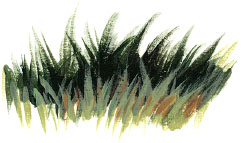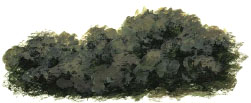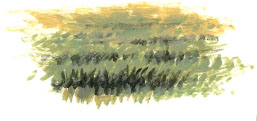Creating Backgrounds
The background is frequently as important as the animal itself. Don’t forget to include some of your subject’s natural setting.
Work on the background and the subject simultaneously. This will make it much easier to integrate the animal with its surroundings. In a painting where the subject is defined by the background colors, such as white ducks against dark water, you will need to paint the background color earlier in the process.
There are two types of backgrounds used in the demos in this book: portrait and full (landscape) backgrounds.
PORTRAIT BACKGROUND
A portrait background usually consists of a basic color that sets off the main subject. There is often some variation, such as darker versions of the color in some areas that are blended into the main color. Another variation can be achieved by drybrushing another color over the original color. If the entire body of the animal is shown, it’s a good idea to paint a shadow or a few sprigs of grass around the subject. A portrait background is often used when a detailed background would distract from the subject, such as when painting a head portrait.
LANDSCAPE BACKGROUND
Landscape backgrounds are more of a challenge, but they can add a lot to a painting. The landscape does not need to have much detail to be effective. In fact, having too much detail in the background will distract the viewer from the focal point. Paint just enough detail to make the background look realistic.

Close-Up Grass
Paint close-up grass with a dark green shadow color and a lighter, basic grass color. Use round brushes to paint flowing, slightly curving strokes that taper at the ends and go in various directions. Overlap the greens and add some brown detail to integrate the animal and/or add realism, since most grass does not look as perfect as a golf course!

Painting Trees
Paint trees with a basic green color mixture, using dabbing strokes and a flat brush. With a lighter green and a round brush, paint some detail to suggest clumps of leaves.

Broad Areas of Grass
Paint broad areas of grass with a combination of vertical and horizontal brushstrokes, with mostly vertical strokes in the foreground, transitioning to more horizontal strokes farther back. Make the strokes smaller as they recede into the landscape.

Clouds
Paint clouds in the sky with a warm white mixture. Use a flat brush and light, feathery dabbing strokes to paint the clouds right over the blue sky. Use a separate brush and the blue sky color to blend the undersides of the clouds with the sky.

Skies
Paint skies with dabbing, semicircular strokes and a flat brush, such as a no. 10 shader. Make the sky lighter at the horizon by adding more Titanium White to a portion of the basic sky color, blending where the two colors meet.
